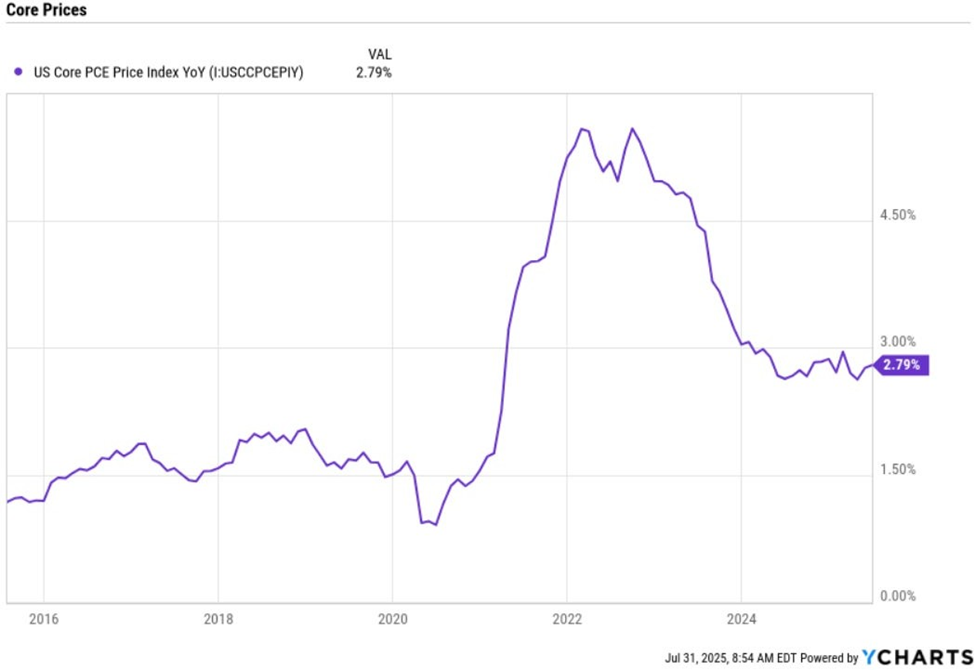
Markets Drop Sharply on Jobs and Inflation Data; Bonds Rise Sharply
Good morning, and welcome to August (already),
The Dow (-2.9%), NASDAQ (-2.2%), and S&P 500 (-2.3%) each fell sharply for the week. Conversely, taxable bonds and tax-free municipal bonds rose sharply, gaining approximately 0.9%. The 10-year Treasury yield fell 0.17% to finish the week at 4.21%.
Most stock losses occurred on Friday when the July jobs report was announced. Not only was the gain in jobs in July weaker than expected, the prior two months were revised downward, suggesting that the economy is slowing, as employers are slowing their hiring. This followed the Fed-favored inflation report, Personal Consumption Expenditures (PCE), that came in slightly above expectations, as core PCE rose 2.8%, compared to economists’ expectations of 2.7%. This data came amid the Fed’s periodic meeting, in which they chose to keep interest rates the same. However, because of the lousy jobs report on Friday, the chance of a rate cut at their next meeting in September rose from 65% to 82%. Typically, the Fed will cut interest rates to spur the economy, but they also fear that interest rate cuts could also fuel inflation. Thus, the Fed is in a jam when inflation is rising, and the jobs market and/or economy are slowing. See the chart below that shows the PCE over the last 10 years. It should also be noted that Fed rate cuts are typically met with investor enthusiasm, often driving stock markets to rise.

Corporate earnings season is entering its last hot week, as about 20% of the S&P 500 will report their earnings, as most will have reported by the end of this week. Thus far, corporate earnings have been better than expected, suggesting a good 2nd quarter, but they beat lower expectations due to tariff uncertainty that peaked in April. Notably, four big tech companies reported earnings with two of them hitting the headlines. Microsoft easily exceeded their earnings expectations, vaulting that stock up almost 10%. Conversely, Amazon reported disappointing earnings and, more importantly, suggested a tepid consumer outlook, which caused the markets to fall sharply and offset Microsoft’s stellar earnings report. Those are two of the seven well-known companies heavily involved in artificial intelligence (AI), in which those seven AI-related stocks have led the markets for the past 2 – 3 years.
Lastly, the tariff deadline of August 1 has come and gone with several key countries (including the European Union) inking trade deals at the last minute with the US. However, several key countries did NOT ink deals, raising tariff concerns with those countries. That drama is expected to continue, but the uncertainty is far less than it was in April, which caused the markets to spiral down sharply. We have since recovered from that drop, with the markets hitting new highs prior to last week. The remainder of corporate earnings, trade deals, and the chance of a Fed rate cut can be expected to drive the markets and volatility for the next several weeks.
Have a great day and terrific week!

Source: Yahoo Finance
Content in this material is for general information only and not intended to provide specific advice or recommendations for any individual. All performance referenced is historical and is no guarantee of future results. All indices are unmanaged and may not be invested into directly.
The economic forecasts set forth in this material may not develop as predicted and there can be no guarantee that strategies promoted will be successful.
The Standard & Poor’s 500 Index (S&P500) is a capitalization-weighted index of 500 stocks designed to measure performance of the broad domestic economy through changes in the aggregate market value of 500 stocks representing all major industries. The NASDAQ Composite Index measures all NASDAQ domestic and non-U.S. based common stocks listed on The NASDAQ Stock Market. The market value, the last sale price multiplied by total shares outstanding, is calculated throughout the trading day, and is related to the total value of the Index. Government bonds and Treasury bills are guaranteed by the US government as to the timely payment of principal and interest and, if held to maturity, offer a fixed rate of return and fixed principal value.



